I know that motors are inductive loads. Does the inductance of a 3 phase motor depend on the load on the motor?
-
maybe related: [Is it valid to consider back-EMF in a DC motor equivalent to increased inductance?](http://electronics.stackexchange.com/questions/53807/is-it-valid-to-consider-back-emf-in-a-dc-motor-equivalent-to-increased-inductanc) – Phil Frost Jul 19 '13 at 19:41
2 Answers
If you look at the equivalent circuit of an induction motor, you can see the only thing that depends on the motor's speed is the rotor resistance \$R_r^\prime / s\$. This is approximately zero at 0 RPM and high at full RPM. The inductances \$jX_s\$, \$jX_r^\prime\$ and \$jX_m\$ don't change. (Note the slip \$s\$ is related to the % mechanical load by the torque-speed curve of the motor)

The practical effect of this is that the inductances in the equivalent circuit don't change with loading, but the power factor does. See the power factor curve on the graph below. These performance curve are for a 220 kW submersible pump, but general-purpose induction motors have similar characteristics.

- 8,931
- 27
- 50
The inductance of the motor can be altered a little by the mechanical load on it (and I'm not considering "strange" loads that could enhance the inductance by mechanically synchronizing with the AC).
The standard three phase motor (induction motor) behaves rather like a transformer and many text books show it's equivalent circuit the same as one. Where it differs is in component values - in a transformer, most of the flux is coupled to the secondary giving rise to small ish leakage inductances that can be largely approximated to zero unless doing a more rigourous analysis.
Not true for the induction motor - it doesn't couple magnetic flux to the rotor as efficiently as a transformer and therefore it's equivalent circuit has a high leakage inductance value compared to transformers. This is stator leakage inductance and doesn't vary with load.
Applying a load will slow the motor but this is the same as applying a resistor to the o/p of a transformer. However, some variation in inductance may be seen under load-speeds because there is greater "slip" in the rotor and some rotors are designed to have different coils work at different slip frequencies.
This will change the inductance of the rotor which of course will be seen as a change in inductance as seen by the supply but, I think, this is swamped by the leakage inductance of the stator.
- 434,556
- 28
- 351
- 777